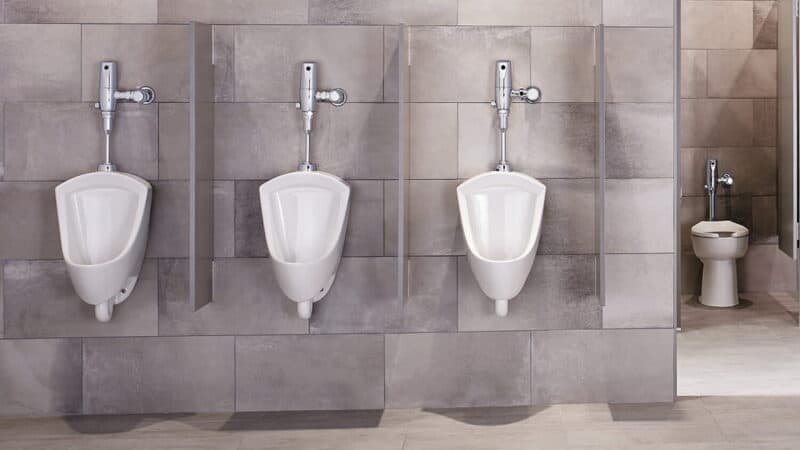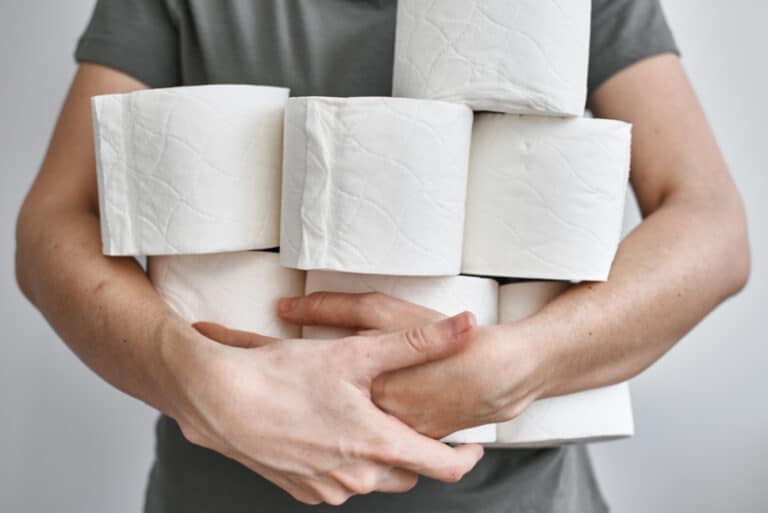10 Different Types of Urinals to Choose From

When it comes to urinals, there are a variety of different types to choose from. Each type has its own benefits that can be advantageous in different situations. In the end, it comes down to personal preferences and it’s fun to learn about appearance, price, and function.
In this blog post, we will go over 10 different types of urinals so that you might be able to determine which urinal you prefer. The types of urinals we’re going to cover are:
- Standard
- Wall-Mounted
- Corner
- Compact
- Free-Standing
- Portable
- Automatic
- Dual-Flush
- Waterless
- Urine Diverting
Let’s start with the standard model we’re all probably used to seeing.
1. Standard Urinal: The standard urinal is the most common type of urinal. It is a simple, rectangular basin that is attached to the wall. Standard urinals are typically made of porcelain or ceramic and are found regularly in public bathrooms.
The main benefit of a standard urinal is that it is very easy to use. There is no need to fumble with any buttons or levers, you can simply walk up and use them. Standard urinals are also very affordable (perhaps why they’re so common), making them a good option for budget-conscious buyers.
2. Wall-Mounted Urinal: A wall-mounted urinal is similar to a standard urinal; however, it is mounted on the wall instead of being attached to the floor. Wall-mounted urinals are typically made of stainless steel or porcelain (more common).
The main advantage of a wall-mounted urinal is that it takes up less space than a standard urinal. This can be beneficial in small bathrooms where every inch counts. Wall-mounted urinals, like standing ones, are commonly found in public bathrooms.
3. Corner Urinal: A corner urinal is a type of urinal that is designed to fit in the corner of a room. Corner urinals are usually made of porcelain or ceramic.
The main strong point of a corner urinal is that it can save space in a small bathroom. Additionally, for those who prefer more privacy, corner urinals do not have a urinal next to them since they stand solo in a corner.
4. Compact Urinal: A compact urinal is a smaller version of a standard urinal. Compact urinals are typically made of porcelain or ceramic.
The main benefit of a compact urinal is that it takes up less space than a standard urinal. This is great for small bathrooms where there isn’t a lot of space.
5. Free-Standing Urinal: A free-standing urinal is a type of urinal that is not attached to the wall or the floor. Free-standing urinals are usually made of stainless steel or porcelain.
The main advantage of a free-standing urinal is that it can be placed in any location in the bathroom, giving you more flexibility with your layout.
6. Portable Urinal: A portable urinal is a type of urinal that can be moved from one location to another. Portable urinals are typically made of plastic or stainless steel.
The main utility of a portable urinal is that it can be used just about anywhere, making it ideal for camping, road trips, or other situations where a bathroom may not be readily available.
7. Automatic Urinal: An automatic urinal is a type of urinal that flushes automatically after each use. Automatic urinals are usually made of stainless steel.
The main benefit of an automatic urinal is that it helps to keep the urinal clean and sanitary. They are also more sanitary for the user because they don’t have to touch it to flush it. For this reason alone, automatic urinals are my favorite.
8. Dual-Flush Urinal: A dual-flush urinal (yes, they exist) is a type of urinal that has two flush options, one for liquid waste and one for solid waste. Dual-flush urinals are usually made of porcelain or ceramic.
The main advantage of a dual-flush urinal is that it can save water by using different amounts of water depending on the type of waste being flushed.
9. Waterless Urinal: A waterless urinal is a type of urinal that does not use water for flushing. Waterless urinals are typically made of plastic or stainless steel.
The main benefit of a waterless urinal is that it saves a significant amount of water over time. This is a great option for those who are trying to reduce their ecological footprint.
10. Urine Diverting Urinal: A urine diverting urinal is a type of urinal that captures urine in a separate chamber from the bowl, preventing it from coming into contact with the bowl and reducing odors.
The main strong point of a urine diverting urinal is that it helps keep the bathroom free from odors.
Choosing Your Preferred Urinal
There are a number of benefits that come with choosing the right urinal for your needs. Urinals can save water, reduce odors, and prevent the spread of germs. The type of urinal you choose will depend on your specific needs and preferences.
Four common factors people think about are:
- Saving water
- Reducing odors
- Preventing germs
- Type and cost of material
Let’s explore these four factors in more detail, starting with the ability to save water.
1. Choosing the right urinal, if you’re interested, can save a significant amount of water over time. Waterless urinals and dual-flush urinals are two types of urinals that can save water.
2. Some urinals— like urine diverting urinals—can reduce odors in your bathroom. Urine diverting urinals prevent urine from coming into contact with the bowl, which reduces odors.
3. If you have hygiene in mind, you can prevent the spread of germs in your bathroom. Automatic urinals flush automatically after each use, which helps to keep the urinal clean and sanitary. Portable urinals are also more hygienic than standard urinals, as they are less likely to collect dirt and grime.
4. The material of your urinal is also important to consider. Urinals made of porcelain or ceramic are typically more durable than those made of plastic or stainless steel. However, plastic and stainless steel urinals are typically more affordable than porcelain or ceramic urinals.
What Types of Urinals are the Most Efficient?
There are a number of factors to consider when choosing an efficient urinal. For example, waterless urinals and dual-flush urinals are two types of urinals that can save water. Urine diverting urinals prevent urine from coming into contact with the bowl, which reduces odors. Automatic urinals flush automatically after each use, which helps to keep the urinal clean and sanitary.
Certain countries and places in the world give a greater focus to sanitation. In India, for example, automatic urinals are sought after. According to The Better India, in India, an automatic urinal “consists of a bulged portion acting as a temporary water reservoir. When the person stands near the urinal to use it, the pre-specified quantity of water automatically gets loaded into the temporary water reservoir. When the person leaves, the water collected in the reservoir automatically gets dispensed into the urinal”.
Efficiency means different things to different people. It all depends on what factors you’re most interested in. So, when choosing an efficient urinal, it is important to consider your specific needs and preferences.
What Types of Urinals Have the Best Aesthetics?
Some people prefer the aesthetics of a waterless urinal, while others prefer the aesthetics of a dual-flush urinal. In order to determine which type is the most visually-pleasing to you, you’ll need to take a glance at them all.
A compact urinal, for example, is probably the best aesthetic choice for small rooms because it doesn’t take up much space. A standard urinal in a small room wouldn’t be the best aesthetic choice due to its size.
Your Favorite Urinal Type
Which is your favorite choice? For me, it’s the portable type because I travel often. I find it convenient to use because I can take it anywhere. However, if I’m not traveling, I prefer the automatic due to not having to touch any germs on a urinal handle.
For you, however, your needs might be different. In our current health environment, where people are ever more conscious of hygiene, you might prefer an automatic type also.
Before you go, I’ll give you a fun fact about the history of urinals. They became popular in the late 1700s. According to CleanLink, “the U.S. industrial revolution made urinals famous. Factories hired hundreds of men, which meant large areas of the factory floor had to be designated for restrooms. By installing urinals, less restroom space was necessary.”
So, I’m sure after reading this you’ll keep an eye for for different urinal types. This is especially true when you’re in a public restroom, which seems to have the automatic urinal type more often these days.






